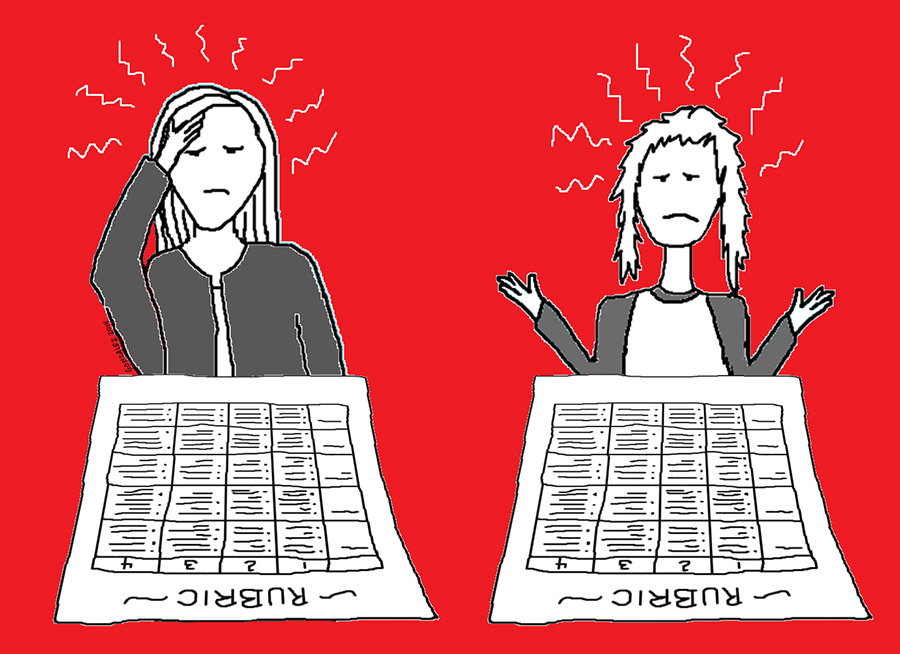
17 Oct Why the Label ‘Exceeds Standard’ Doesn’t Work
Today’s guest post is written by Thomas Guskey, Professor of Educational Psychology at the University of Kentucky.
Educators implementing standards-based approaches to grading and reporting often struggle with how to label different levels of students’ performance. Four levels of performance is the most common number identified. Most educators in the U.S. and Canada consider three levels to be insufficient in discriminating important differences in students’ performance. When the number of levels climbs to five or six, however, the consistency of teachers’ rating diminishes rapidly.
In choosing labels for these levels, many begin by describing level 3 as “Proficient.” This level of performance means the student has achieved the learning target and mastered the standard. Level 2 is typically considered “Progressing” or “Approaching” mastery of the standard, and level 1 is deemed “Struggling” or “Needs Improvement.” The challenge comes in labeling the highest, level 4. 2
Some educators believe that level 4 should designate a truly exceptional level of achievement – the student whose performance “knocks your socks off.” They use this level to recognize students who do something special related to the standard or demonstrate genuinely outstanding performance regarding the standard.
Others believe level 4 should describe performance at a more complex or more advanced level with regard to the standard. They use the label “Exceeds Standard” to indicate the student has gone beyond or above what was expected. In other words, these students have achieved at a higher and more sophisticated level. But while seeming reasonable, serious communication problems often arise when educators try to clarify the meaning of “Exceeds Standard” to students, parents, and fellow educators.
Evidence gathered from parents and families shows that many find the label “Exceeds Standard” to be vague and difficult to interpret. The message it implies to them from educators is: “More than we expect, but we cannot tell you precisely what that is until we see it!” Such imprecision troubles parents, especially those who encourage their child to strive for the highest grade possible in every subject.
From a practical perspective, “Exceeds Standard” presents additional difficulties. In most standards-based environments, mastering a standard means hitting the target. It signifies achieving the goal and learning what was expected. Olympic archers who place their arrows in the center of the bulls-eye from a distance of 70 meters, for example, have “hit the target.” They have achieved the goal and accomplished precisely what was expected.
How then could an Olympic archer ever “exceed” the standard? How would the archer achieve at a more advanced or higher level? Maybe we could make the bulls-eye smaller or move the target further away from the archer, making it more difficult to hit the bulls-eye.
The problem with that, however, is it changes the standard. As soon as you make the task more difficult or move the learning expectation to a higher and more advanced level, you have changed the standard and altered the goal. Students who achieve at that level have not really “exceeded the standard.” More accurately, they have mastered a different standard. If you want archers to hit smaller bulls-eyes from a greater distance, then that becomes the new standard for archers.
Some argue that “Proficient” can imply placing arrows near the bulls-eye while “Exceeds Standard” means actually hitting the bulls-eye directly. But does “Proficient” then mean “almost” hitting the target? Is “getting close” sufficient? And if it is, then how close is good enough? Who makes that decision?
This interpretation problem also affects educators’ who want to equate these distinctions to percent correct on assessments. On an assessment designed to measure students’ ability to solve single-digit addition problems, for example, they might designate students who get 80% correct to be “Proficient,” while those students who answer correctly 90% or more are rated, “Exceeds Standard.” But have students who get 90% correct truly “exceeded” the standard? 3
Others counter that the assessment for this standard should include double-digit addition problems as well. Students who answer the double-digit problems correctly can then accurately be rated as “Exceeds Standard.” But again, this miscommunicates what is measured. With the inclusion of double-digit addition problems, the assessment clearly measures a different standard. The same holds true if “Proficient” requires students to “apply” what they have learned, while “Exceeds Standard” involves the higher level skills of “analyzing” or “synthesizing.” The point is that you are now measuring a different standard.
The nature of specific standards makes things even more complicated. If the standard relates to students’ ability to safely cross a busy street, for example, would anyone consider 80% to be “Proficient”? Or even 90%? What about being honest or telling the truth? And in these examples, how could students ever reach “Exceeds Standard”?
This does not imply that exceptional performance should go unrecognized. Not at all. A grade that denotes truly distinguished performance can be useful in many instances. But if such a grade is included in the grading system, then it must be associated with clear criteria that identify precisely how such a grade can be attained. Those criteria must be clearly communicated to students and parents alike, accompanied by illustrative examples of students’ performance or samples of students’ work, and agreed upon by fellow teachers.
With these criteria articulated and openly communicated to all stakeholders, labels such as “Distinguished,” “Exceptional,” or “Exemplary” generally serve intended communication purposes far better than “Exceeds Standard.”
Connect with Tom Guskey on Twitter at @tguskey.
Check it out here:
Why the Label ‘Exceeds Standard’ Doesn’t Work | Education Week
PostedOctober 17, 2014 7:30 AM by Peter DeWitt




Sorry, the comment form is closed at this time.